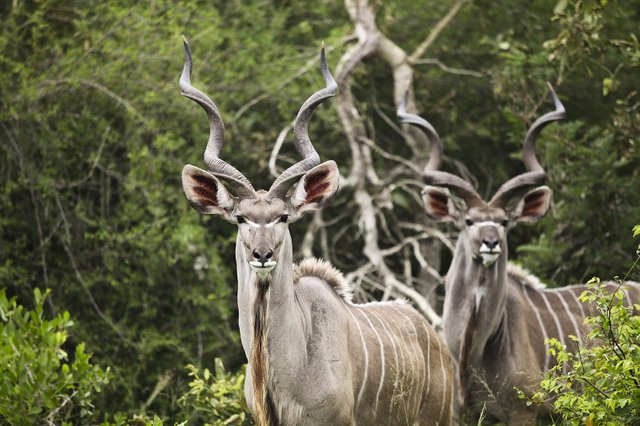kudu

The kudu is a sub-types of impala that is discovered possessing blended bush forest, and savanna fields in eastern and southern Africa. The kudu depends vigorously on close, thick bushes in which the kudu can escape to and stow away when it feels undermined.
There are two types of kudu in Africa which are the Lesser kudu and the Greater kudu. Both kudu species are firmly related and look fundamentally the same as in appearance yet there are a couple of unmistakable ways that the lesser kudu and the more noteworthy kudu can be recognized from each other. The lesser kudu has ten white stripes which run vertically down the lesser kudu's body where the more noteworthy kudu can have in any case in the vicinity of 4 and 12 stripes. The more noteworthy kudu is additionally for the most part greater than the lesser kudu
Kudus are herbivorous creatures and hence have a totally vegan count calories. Kudus scrounge in forest and around shrubberies of bushes snacking on leaves from the trees and hedges. Kudus likewise eat different assortments of vegetation, for example, herbs, blossoms, berries and fallen natural products.
Kudus are prey to various predators, for example, lions, panthers, cheetahs, wild pooches and the intermittent substantial python that will chase the littler and more powerless kudu youthful. Kudu can run quick however frequently experience considerable difficulties surpassing predators so the kudu depend on their lithe capacity to jump into backwoods and forest where huge predatory predators think that its harder to pursue them. The kudu will then frequently stow away in forest until the point that the predator have in the long run surrendered and left.
Kudus live in little crowds of up to 24 kudu people. The kudu groups principally comprise of female kudus and their calves as male kudus watch out for single and just meet up with different kudus when the time has come to mate. It has been realized that gatherings of up to 8 male kudus will frame a crowd however this is exceptionally uncommon.
The kudu mating season happens toward the finish of the stormy season. The kudu incubation period is around 8 months after which time the female kudu will ordinarily bring forth only one child kudu. The child kudus have a tendency to be conceived around February and March when the grass is busy's most noteworthy and there is a lot of nourishment to help the infant kudu calves to develop.
Kudus have both profited and experienced contact with people. People discover the kudu and simple focus for chasing because of the way that kudus tend to stop and glance around after they have fled. Some nearby clans individuals trust the kudu to be a holy creature and hence secure the kudu instead of slaughtering it. Human settlements have likewise implied that the kudu environment as changed and the kudu have needed to move to different zones. This has really done the kudu populace the lot of good as the kudu have been pushed into zones where there is a superior wellspring of water and accordingly nourishment.